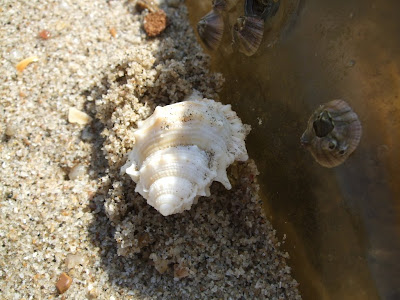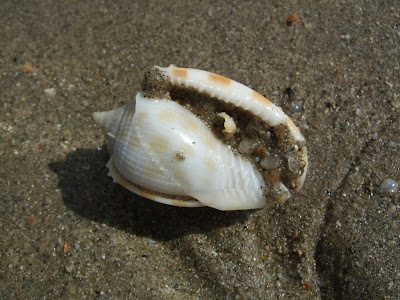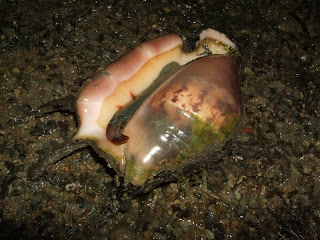In the company of Andy, James, Ria, Travis, the Butterfly Circle and the Dragonfliers, we had almost a 3km walk through gentle slopes of prickly undergrowth, vast stretches of grasses and shady forest. It was my first time checking out this area of Changi but the second for the rest of them. With no clue as to what to expect at all, I thought I might not see much. How wrong! As you will later find out why.
Andy, James and I followed Travis to the shore while the rest headed landwards to check out the butterfly and dragonfly communities that could be found in this new terrain.
James spotted this unusual looking spider. The 'stick-insect-looking thing' is the spider with its legs (appendages) all tucked in and the oval-shaped blob is most likely its egg case.

There was another egg case nearby and it looked dried up.

The journey down to the shore was most delightful. Fair weather and most beautiful sceneries greeted us.



Such burrows were plenty where we first emerged from the forest and out into the open shore. Andy pointed out that these were burrows of the Ghost Crab. The "foot-prints" leading out from the burrows were made by them!
It was my first time seeing a cathode ray tube. They were the ancient TV sets and look like this. According to some of my companions these are pretty common at the shore. This really had us wondering how they got there..
Travis identified this Frog Seashell. This was something new to me, as I am still pretty bad at identifying seashells and snails.
Lying alone on the long stretch of shore was this dead fish. It was the only dead fish we saw.
Then Andy found tracks made by a Malayan Water Monitor Lizard. I realise that according to the nature of tracks we could actually know which animals had been checking out the shore too! It's interesting that this can actually be a form of science as well.
The shore did not disappoint though the tide was high. Seashells of various forms were most prominent and I learnt much indeed. James showed me this empty shell of the Fig Snail.
This curious looking shell was found by Travis. We had no idea what snail this was.
Another pretty shell found by James, the name of which is..I have to check with James again.
Travis found this queer looking shell that could have belonged to a really curvy snail!
A kind of clamshell caught my attention with its rainbow colours.
We traced the shoreline further down and proceeded to what turned out to be a soft sandy patch..
..as well as plenty of live ones. Sand dollars are echinoderms just like the sea stars.
It wasn't hard to notice the winding trails made by the Cake Sand Dollars.
The sandy blob where the trail ends is where a Sand Dollar lays "hidden" underneath.

Note: You should never leave a Sand Dollar upside down as it takes alot of energy and effort for the Sand Dollars to flip themselves back to their upright position.
Soon it was time to head back landwards (and of course, lunchtime!). On the way back we took photos of the shore we explored earlier.
Truly beautiful place indeed! I sincerely hope this place stays pristine. Thanks Travis for sharing with us this wonderful shore!























































































